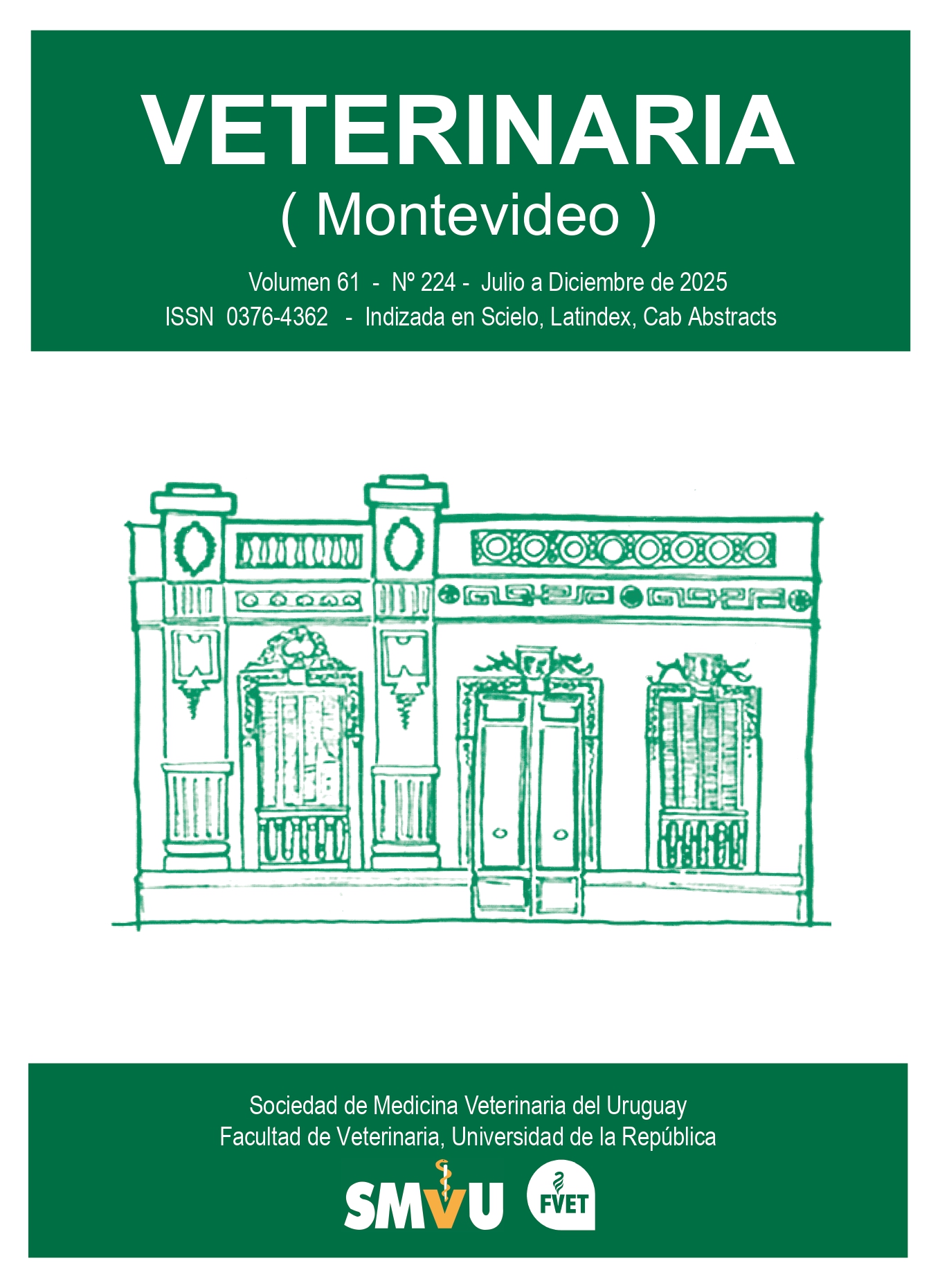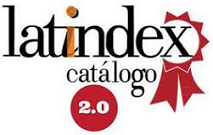Relação entre variáveis climáticas e casos de leptospirose humana
Uruguai, 2010-2023
DOI:
https://doi.org/10.29155/VET.61.224.3Palavras-chave:
Zoonose, Temperatura, Precipitação, Mudança climáticaResumo
A leptospirose é uma zoonose bacteriana de distribuição global. No Uruguai, é endêmica e afeta principalmente trabalhadores rurais e alguns grupos urbanos. Este estudo teve como objetivo analisar a relação entre variáveis climáticas e casos humanos de leptospirose no Uruguai entre 2010 e 2023. As variáveis climáticas foram correlacionadas com os casos mensais confirmados de leptospirose em diferentes períodos de defasagem (lag). Um modelo de regressão binomial negativa foi então ajustado para avaliar o número mensal de casos com base nas variáveis significativamente correlacionadas. Um total de 1218 casos confirmados foi registrado durante o período do estudo. A temperatura média mensal apresentou a maior correlação positiva com os casos do mês seguinte (lag 1) em todo o país. A precipitação acumulada teve a correlação mais forte com os casos em lag 1 tanto em nível nacional quanto na região sul, enquanto no norte a maior correlação foi observada em lag 2. Meses com precipitação acima da média e com inundações apresentaram significativamente mais casos do que os meses com precipitação média ou abaixo da média. Segundo o modelo, cada aumento de 1 °C na temperatura média mensal esteve associado a um aumento de 8,9 % nos casos do mês seguinte, enquanto cada aumento de 10 mm na precipitação acumulada foi associado a um aumento de 3,3 %. Esses achados ressaltam a necessidade de reforçar as ações de prevenção, vigilância e diagnóstico da leptospirose nos centros de saúde, especialmente após meses quentes, chuvosos ou com ocorrência de inundações. Isso é particularmente relevante no contexto das mudanças climáticas, que vêm aumentando as temperaturas médias e a frequência de eventos climáticos extremos.
Downloads
Métricas
Referências
Andre-Fontaine, G., Aviat, F., & Thorin, C. (2015). Waterborne leptospirosis: survival and preservation of the virulence of pathogenic Leptospira spp. in fresh water. Current Microbiology, 71, 136-142.
Aznarez, C., Jimeno-Sáez, P., López-Ballesteros, A., Pacheco, J. P., & Senent-Aparicio, J. (2021). Analysing the impact of climate change on hydrological ecosystem services in Laguna del Sauce (Uruguay) using the SWAT model and remote sensing data. Remote Sensing, 13(10), 2014.
Baharom, M., Ahmad, N., Hod, R., Ja’afar, M. H., Arsad, F. S., Tangang, F., Ali, N., & Osman, Y. (2024). Environmental and occupational factors associated with leptospirosis: A systematic review. Heliyon, 10(1), e23473.
Barragan, V., Olivas, S., Keim, P., & Pearson, T. (2017). Critical knowledge gaps in our understanding of environmental cycling and transmission of Leptospira spp. Applied and Environmental Microbiology, 83(19), e01190-17. https://doi.org/10.1128/AEM.01190-17
Bencloski, J. W. (1982). Air temperature and relative humidity: A simulation. Journal of Geography, 81(2), 64-65. https://doi.org/10.1080/00221348208980713
Bidegain, M., Crisci, C., Del Puerto, L., Inda, H., Mazzeo, N., Taks, J., & Terra, R. (2012). Clima de cambios: nuevos desafíos de adaptación en Uruguay: Vol. 1. Variabilidad climática de importancia para el sector productivo. FAO, MGAP. http://www.fao.org/docrep/field/009/as253s/as253s.pdf
Bidegain, M., Pasten, M., Nagy, G. J., Coronel, G., Ferrer, J., & Arana, I. (2017). Tendencias recientes de las precipitaciones e impactos asociados con ENSO en la cuenca del Río de la Plata. Paraquaria Natural, 5(2), 8-18.
Bierque, E., Thibeaux, R., Girault, D., Soupé-Gilbert, M. E., & Goarant, C. (2020). A systematic review of Leptospira in water and soil environments. PloS one, 15(1), e0227055. https://doi.org/10.1371/journal.pone.0227055
Boiani, L., Berois, N., & D’Elía, G. (2008). Annual male reproductive cycle of a Hantavirus reservoir, the long-tailed mouse Oligoryzomys flavescens (Rodentia; Cricetidae, Sigmodontinae) from Uruguay. Mastozoología Neotropical, 15(1), 23-32.
Cameron, A. C., & Trivedi, P. K. (1990). Regression-based tests for overdispersion in the Poisson model. Journal of Econometrics, 46(3), 347-364. https://doi.org/10.1016/0304-4076(90)90014-K
Casanovas-Massana, A., Pedra, G. G., Wunder Jr, E. A., Diggle, P. J., Begon, M., & Ko, A. I. (2018). Quantification of Leptospira interrogans survival in soil and water microcosms. Applied and Environmental Microbiology, 84(13), e00507-18. https://doi.org/10.1128/AEM.00507-18
Cassadou, S., Rosine, J., Flamand, C., Escher, M., Ledrans, M., Bourhy, P., Leparc-Goffart, I., & Quénel, P. (2016). Underestimation of leptospirosis incidence in the French West Indies. PLoS Neglected Tropical Diseases, 10(4), e0004668. https://doi.org/10.1371/journal.pntd.0004668
Chery, G., Francis, L., Hunte, S. A., & Leon, P. (2020). Epidemiology of human leptospirosis in Saint Lucia, 2010–2017. Revista Panamericana de Salud Pública, 44, e160. https://doi.org/10.26633/RPSP.2020.160
Coelho, M. S., & Massad, E. (2012). The impact of climate on Leptospirosis in São Paulo, Brazil. International Journal of Biometeorology, 56, 233-241. https://doi.org/10.1007/s00484-011-0419-4
Davignon, G., Cagliero, J., Guentas, L., Bierque, E., Genthon, P., Gunkel-Grillon, P., Vernel-Pauillac, F., & Goarant, C. (2023). Leptospirosis: toward a better understanding of the environmental lifestyle of Leptospira. Frontiers in Water, 5, 1195094. https://doi.org/10.3389/frwa.2023.1195094
De Oliveira, D., Figueira, C. P., Zhan, L., Pertile, A. C., Pedra, G. G., Gusmão, I. M., Carvalho-Costa, F. A., & Costa, F. (2016). Leptospira in breast tissue and milk of urban Norway rats (Rattus norvegicus). Epidemiology & Infection, 144(11), 2420-2429. https://doi.org/10.1017/S0950268816000637
Desvars, A., Cardinale, E., & Michault, A. (2011). Seasonality of human leptospirosis in Reunion Island (Indian Ocean) and its association with meteorological data. Epidemiology and Infection, 139(6), 837-846. https://doi.org/10.1371/journal.pone.0020377
Dias, C. S., & Pinna, M. H. (2025). Leptospira biofilms: implications for survival, transmission, and disease management. Applied and Environmental Microbiology, 91(2), e01914-24. https://doi.org/10.1128/aem.01914-24
Ellis, T., Imrie, A., Katz, A. R., & Effler, P. V. (2008). Underrecognition of leptospirosis during a dengue fever outbreak in Hawaii, 2001–2002. Vector-Borne and Zoonotic Diseases, 8(4), 541-548. https://doi.org/10.1089/vbz.2007.0241
Ellis, W. A. (2014). Animal leptospirosis. En B. Adler (Ed.), Leptospira and leptospirosis (pp. 99-137). Springer. https://doi.org/10.1007/978-3-662-45059-8_6
Ercides Péres, W., Russo, A., & Nunes, B. (2019). The association between hydro-meteorological events and leptospirosis hospitalizations in Santa Catarina, Brazil. Water, 11(5), 1052. https://doi.org/10.3390/w11051052
Ghizzo Filho, J., Nazário, N. O., Freitas, P. F., Pinto, G. D. A., & Schlindwein, A. D. (2018). Temporal analysis of the relationship between leptospirosis, rainfall levels and seasonality, Santa Catarina, Brazil, 2005-2015. Revista do Instituto de Medicina Tropical de São Paulo, 60, e39. https://doi.org/10.1590/S1678-9946201860039
Gomard, Y., Dellagi, K., Goodman, S. M., Mavingui, P., & Tortosa, P. (2021). Tracking animal reservoirs of pathogenic Leptospira: The right test for the right claim. Tropical Medicine and Infectious Disease, 6(4), 205. https://doi.org/10.3390/tropicalmed6040205
Guimarães, R. M., Cruz, O. G., Parreira, V. G., Mazoto, M. L., Vieira, J. D., & Asmus, C. I. R. F. (2014). Temporal analysis of the relationship between leptospirosis and the occurrence of flooding due to rainfall in the city of Rio de Janeiro, Brazil, 2007-2012. Ciencia & Saude Coletiva, 19(9), 3683-3692. https://doi.org/10.1590/1413-81232014199.06432014
Gutierrez, J. D. (2021). Effects of meteorological factors on human leptospirosis in Colombia. International Journal of Biometeorology, 65(2), 257-263. https://doi.org/10.1007/s00484-020-02028-2
Hagedoorn, N. N., Maze, M. J., Carugati, M., Cash-Goldwasser, S., Allan, K. J., Chen, K., Cossic, B., Demeter, E., Gallagher, S., German, R., Galloway, R. L., Habuš, J., Rubach, M. P., Shiokawa, K., Sulikhan, N., & Crump, J. A. (2024). Global distribution of Leptospira serovar isolations and detections from animal host species: A systematic review and online database. Tropical Medicine & International Health, 29(3), 161-172. https://doi.org/10.1111/tmi.13965
Hammer, Ø., Harper, D. A. T., & Ryan, P. D. (2001). PAST: Paleontological Statistics Software Package for Education and Data Analysis. Palaeontologia Electronica, 4(1), 4. https://doc.rero.ch/record/15326/files/PAL_E2660.pdf
Heldstab, S. A. (2021). Latitude, life history and sexual size dimorphism correlate with reproductive seasonality in rodents. Mammal Review, 51(2), 256-271. https://doi.org/10.1111/mam.12231
Imai, C., Armstrong, B., Chalabi, Z., Mangtani, P., & Hashizume, M. (2015). Time series regression model for infectious disease and weather. Environmental Research, 142, 319-327. https://doi.org/10.1016/j.envres.2015.06.040
Inamasu, Y., Nikaido, Y., Miyahara, S., Maruoka, T., Takigawa, T., Ogawa, M., Sato, M., & Saito, M. (2022). Dissemination of Leptospira into the intestinal tract resulting in fecal excretion in a hamster model of subcutaneous infection with Leptospira interrogans. Microbial Pathogenesis, 165, 105481. https://doi.org/10.1016/j.micpath.2022.105481
Instituto Nacional de Investigación Agropecuaria. (2024). Banco de datos agroclimático. https://www.inia.uy/gras/Clima/Banco-datos-agroclimatico
Intergovernmental Panel on Climate Change. (2021). Climate Change 2021: The Physical Science Basis. Contribution of Working Group I to the Sixth Assessment Report of the Intergovernmental Panel on Climate Change. Cambridge University Press. https://doi.org/10.1017/9781009157896
Lau, C. L., Smythe, L. D., Craig, S. B., & Weinstein, P. (2010). Climate change, flooding, urbanisation and leptospirosis: fuelling the fire? Transactions of the Royal Society of Tropical Medicine and Hygiene, 104(10), 631-638. https://doi.org/10.1016/j.trstmh.2010.07.002
López, M. S., Müller, G. V., Lovino, M. A., Gómez, A. A., Sione, W. F., & Pomares, L. A. (2019). Spatio-temporal analysis of leptospirosis incidence and its relationship with hydroclimatic indicators in northeastern Argentina. Science of the Total Environment, 694, 133651. https://doi.org/10.1016/j.scitotenv.2019.133651
Matsushita, N., Ng, C. F. S., Kim, Y., Suzuki, M., Saito, N., Ariyoshi, K., Koizumi, N., & Hashizume, M. (2018). The non-linear and lagged short-term relationship between rainfall and leptospirosis and the intermediate role of floods in the Philippines. PLoS Neglected Tropical Diseases, 12(4), e0006331. https://doi.org/10.1371/journal.pntd.0006331
Meny, P., Menéndez, C., Ashfield, N., Quintero, J., Rios, C., Iglesias, T., Vignolo, L., & Varela, G. (2019). Seroprevalence of leptospirosis in human groups at risk due to environmental, labor or social conditions. Revista Argentina de Microbiología, 51(4), 324-333. https://doi.org/10.1016/j.ram.2019.01.005
Ministerio de Salud Pública. (2015). Guía Nacional de Vigilancia y Control de Enfermedades y Eventos Sanitarios de Notificación Obligatoria. https://www.gub.uy/ministerio-salud-publica/comunicacion/publicaciones/guia-nacional-vigilancia-control-enfermedades-eventos-sanitarios
Monahan, A. M., Callanan, J. J., & Nally, J. E. (2009). Host-pathogen interactions in the kidney during chronic leptospirosis. Veterinary Pathology, 46(5), 792-799. https://doi.org/10.1354/vp.08-VP-0265-N-REV
Montenegro-Idrogo, J. J., Bonilla-Aldana, D. K., & Rodríguez-Morales, A. J. (2024). Risk of human leptospirosis in Colombia: spatiotemporal analysis and related hydroclimatic factors. Transactions of The Royal Society of Tropical Medicine and Hygiene, 18(9), 605-615. https://doi.org/10.1093/trstmh/trae013
Monti, G., Montes, V., Tortosa, P., Tejeda, C., & Salgado, M. (2023). Urine shedding patterns of pathogenic Leptospira spp. in dairy cows. Veterinary Research, 54(1), 64. https://doi.org/10.1186/s13567-023-01190-w
Munoz-Zanzi, C., Groene, E., Morawski, B. M., Bonner, K., Costa, F., Bertherat, E., & Schneider, M. C. (2020). A systematic literature review of leptospirosis outbreaks worldwide, 1970-2012. Revista Panamericana de Salud Pública, 44, e78. https://doi.org/10.26633/RPSP.2020.78
Nagy, G.J., Bidegain, M., Verocai, J., & de los Santos, B. (2016a). Escenarios climáticos futuros sobre Uruguay. Basados en los nuevos escenarios socioeconómicos RCP (Project Report PNUD URU/11/G31). Climate Change Division; MVOTMA.
Nagy, G. J., Coronel, G., Pastén, M., Báez, J., Monte-Domecq, R., Galeano-Rojas, A., Cabrera, S., & Arana, I. (2016b). Impacts on well-being and health by excessive rainfall and floods in Paraguay, Uruguay and Bolivia. En W. Leal, U. M. Azeiteiro & F. Alves (Eds.), Climate Change and Health (pp. 475-514). Springer. https://doi.org/10.1007/978-3-319-24660-4_27
Pappas, G., Papadimitriou, P., Siozopoulou, V., Christou, L., & Akritidis, N. (2008). The globalization of leptospirosis: worldwide incidence trends. International Journal of Infectious Diseases, 12(4), 351-357. https://doi.org/10.1016/j.ijid.2007.09.011
Pinto, G. V., Senthilkumar, K., Rai, P., Kabekkodu, S. P., Karunasagar, I., & Kumar, B. K. (2022). Current methods for the diagnosis of leptospirosis: Issues and challenges. Journal of Microbiological Methods, 195, 106438. https://doi.org/10.1016/j.mimet.2022.106438
Plank, R., & Dean, D. (2000). Overview of the epidemiology, microbiology, and pathogenesis of Leptospira spp. in humans. Microbes and Infection, 2(10), 1265-1276. https://doi.org/10.1016/S1286-4579(00)01280-6
R Core Team. (2024). R: A language and environment for statistical computing. R Foundation for Statistical Computing. https://www.R-project.org/
Saito, M., Villanueva, S. Y. A. M., Chakraborty, A., Miyahara, S., Segawa, T., Asoh, T., Ozuru, R., Gloriani, N. G., Yanagihara, Y., & Yoshida, S. (2013). Comparative analysis of Leptospira strains isolated from environmental soil and water in the Philippines and Japan. Applied and Environmental Microbiology, 79(2), 601-609. https://doi.org/10.1128/AEM.02728-12
Sánchez, A., Contreras, A., Corrales, J. C., & de la Fe, C. (2022). In the beginning it was zoonosis: One Health to combat this and future pandemics. SESPAS Report 2022. Gaceta Sanitaria, 36 (Suppl.), S61-S67. https://doi.org/10.1016/j.gaceta.2022.01.012
Sant’Anna da Costa, R., N., Di Azevedo, M. I., dos Santos Baptista Borges, A. L., Carvalho-Costa, F. A., Martins, G., & Lilenbaum, W. (2021). Persistent high leptospiral shedding by asymptomatic dogs in endemic areas triggers a serious public health concern. Animals, 11(4), 937. https://doi.org/10.3390/ani11040937
Schelotto, F., Hernández, E., González, S., Del Monte, A., Ifran, S., Flores, K., Pardo, L., Parada, D., Filippini, M., Balseiro, V., Geymonat, J. P., & Varela, G. (2012). A ten-year follow-up of human leptospirosis in Uruguay: an unresolved health problem. Revista do Instituto de Medicina Tropical de São Paulo, 54, 69-76. https://doi.org/10.1590/s0036-46652012000200003
Schober, P., Boer, C., & Schwarte, L. A. (2018). Correlation coefficients: appropriate use and interpretation. Anesthesia & analgesia, 126(5), 1763-1768. https://doi.org/10.1213/ANE.0000000000002864
Silva, A. E. P., Conceição, G. M. D. S., & Chiaravalloti Neto, F. (2020). Spatial analysis and factors associated with leptospirosis in Santa Catarina, Brazil, 2001-2015. Revista da Sociedade Brasileira de Medicina Tropical, 53, e20200466. https://doi.org/10.1590/0037-8682-0466-2020
Sistema Nacional de Emergencia. (2022). Inundaciones. https://www.gub.uy/sistema-nacional-emergencias/inundaciones
Smith, D. J. W., & Self, H. R. M. (1955). Observations on the survival of Leptospira australis A in soil and water. Epidemiology & Infection, 53(4), 436-444. https://doi.org/10.1017/S0022172400000942
Soni, N., Eyre, M. T., Souza, F. N., Diggle, P. J., Ko, A. I., Begon, M., Childs, J. E., & Costa, F. (2024). Disentangling the influence of reservoir abundance and pathogen shedding on zoonotic spillover of the Leptospira agent in urban informal settlements. Frontiers in Public Health, 12, 1447592. https://doi.org/10.3389/fpubh.2024.1447592
Suanes, A., Macchi, M. V., Fernández, F., Salaberry, X., Moreira, C., & Gil, A. D. (2024). Seroprevalence and herd-level associated factors of pathogenic Leptospira spp. circulating locally in dairy cattle in Uruguay. Preventive Veterinary Medicine, 223, 106097. https://doi.org/10.1016/j.prevetmed.2023.106097
Tamayo, I., Mahiques, J., & Mughini, L. (2013). Temporal distribution and weather correlates of Norway rat (Rattus norvegicus) infestations in the city of Madrid, Spain. EcoHealth, 10, 137-144. https://doi.org/10.1007/s10393-013-0829-3
Ternova, L., Verger, L., & Nagy, G. J. (2024). Reviewing Planetary Health in light of Research Directions in One Health. Research Directions: One Health, 2, e7. https://doi.org/10.1017/one.2024.3
Vadell, M. V., Cavia, R., & Suarez, O. V. (2010). Abundance, age structure and reproductive patterns of Rattus norvegicus and Mus musculus in two areas of the city of Buenos Aires. International Journal of Pest Management, 56(4), 327-336. https://doi.org/10.1080/09670874.2010.499479
Vanasco, N. B., Schmeling, M. F., Lottersberger, J., Costa, F., Ko, A. I., & Tarabla, H. D. (2008). Clinical characteristics and risk factors of human leptospirosis in Argentina (1999–2005). Acta Tropica, 107(3), 255-258. https://doi.org/10.1016/j.actatropica.2008.06.007
Venables, W. N., & Ripley, B. D. (2013). Modern applied statistics with S-PLUS. Springer Science & Business Media.
Vidal, B., Verger, L., & Nagy, G.J. (2024a). Emergent and re-emergent zoonotic infectious diseases in Uruguay (2004-2024) and socio-environmental changes. A one health perspective. MedCrave Online Journal of Public Health, 13(3),154-159.
Vidal, B., Verger, L., & Nagy, G.J. (2024b). Emergent and re-emergent zoonotic infectious diseases in Uruguay (2004-2024). Part II: Arboviral diseases. MedCrave Online Journal of Public Health, 13(3),178‒185.
Vijayachari, P., Sugunan, A. P., & Shriram, A. N. (2008). Leptospirosis: an emerging global public health problem. Journal of Biosciences, 33(4), 557-569. https://doi.org/10.1007/s12038-008-0074-z
Wasinski, B., & Dutkiewicz, J. (2013). Leptospirosis-current risk factors connected with human activity and the environment. Annals of Agricultural and Environmental Medicine, 20(2), 239-244.
Zarantonelli, L., Suanes, A., Meny, P., Buroni, F., Nieves, C., Salaberry, X., Laborde, J., & Grupo de Trabajo Interinstitucional de Leptospirosis Consortium. (2018). Isolation of pathogenic Leptospira strains from naturally infected cattle in Uruguay reveals high serovar diversity, and uncovers a relevant risk for human leptospirosis. PLoS Neglected Tropical Diseases, 12(9), e0006694. https://doi.org/10.1371/journal.pntd.0006694
Publicado
Como Citar
Edição
Seção
Licença
Copyright (c) 2025 Sociedad de Medicina Veterinaria del Uruguay-Facultad de Veterinaria, Universidad de la República

Este trabalho está licenciado sob uma licença Creative Commons Attribution 4.0 International License.











